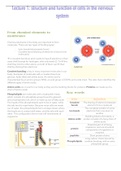From chemical elements to
membranes
Chemical elements in the body are important to form
molecules. There are two types of binding types:
- Ionic bonds (electrostatic force)
- Covalent bond (sharing of electrons is key to form
molecules)
à in covalent bonds an atom wants to have 8 electrons in their
outer shell (except for hydrogen, who only wants 2). To fill this
shell they bind to other atoms, so both of them can fill their
shell by sharing their electrons. Covalent bond
Covalent bonding is key in many important molecules in our
body. Examples of molecules with a covalent bond are
glucose, lipids (fats) and amino acids. An amino acid is
characterized by an amino group (-NH2), an acid group (-COOH), and a side chain. The side chain identifies the
different types of amino acids.
Amino acids are crucial for our body as they are the building blocks for proteins. Proteins are made up of a
chain of amino acids.
Key words
Phospholipids are molecules with a hydrophilic head,
which consists of a phosphate group bound to glycerol,
and a hydrophobic tail, which is made up out of fatty acids. Term Definition
The heads of the phospholipids want to be in water, while Covalent The sharing of electrons between
the tails tend to repel water. Because most cells are made bonds atoms to form a molecule
out of water, the phospholipids form a bilayer sheet, where The complete transfer of some
the heads are in contact with water, and the tails with each Ion bonds electrons from one atom to
other. This configuration forms most cell membranes of another
organisms. Building blocks of proteins, a
Amino acids protein consists of a long chain of
amino acids
Essential part of all living
organisms, and are structural
protein
components of organisms or
enzymes
peptides Short protein chains
Long carbon chains bound by
Phospholipids covalent bonding, with an extra
phosphate group
1
,Nerve cells
The function of nerve cells, also called neurons, is to
receive sensory input from the outside world, to send
motor commands to our muscles, and to transform and
relay electrical signals.
1. Dendrites: receiving of signals
2. Cell body: integration of signals
3. Axon: sending of signals
The axon is covered in a fatty layer, the myelin, this layer
helps to speed up the transduction of electrical signal.
The dendrites – dendrites propagate electrical stimulation received by other neurons to the cell body. They
receive their information via their synapses
The soma – the soma is the cell body of the neuron, and has many functions. For these function multiple cell
organs are present :
- Cell nucleus with pores for mRNA transport
- Endoplasmatic reticulum: production, storage, and protein transport
- Golgi apparatus: post office for packing of neurotransmitters
- Mitochondria: power house of the cell
- Lysosome: waste processing
- Microtubule: road system for transportation of neurotransmitter
The cell nucleus (1) – in the nucleus the chromosomes with the genes are present. The genes are
meaningful pieces of DNA, which are read and converted to messenger RNA (mRNA) during the transcription.
There are two types of signals
1. Excitatory signals: promote the generation
of an action potential in the receiving neuron
2. Inhibitory signals: prevent the generation
of an action potential in the receiving neuron
2
, The axon – the axon sends the signal throughout the neuron. The axon is covered by a fatty layer, known as
myelin, this layer helps to speed up the transduction of electrical signals, but the conduction of action potentials
is also more effective.
Axoplasmic transport is the transport of vesicles throughout the nerve cell. This transport occurs by the moving
(almost like walking) of motor proteins over the microtubule inside the axons. There are two essential motor
proteins:
- Kinesin: protein active in the transport of vesicles from the cell body to the synapses (anterograde
transport)
- Dynein: protein active in the transport of vesicles from the synapses to the cell body (retrograde
transport)
3






